Ballet Russes: Dance and The Avant-Garde
Sergei Diaghilev (1872-1929)
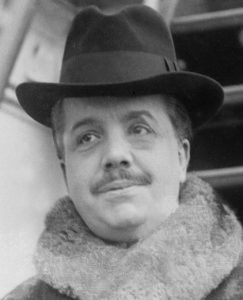
Sergei Diaghilev, a Russian art lover, organized the Ballet Russes in 1909. He identified ballet as the ideal vehicle to present the Russian arts to the West. Diaghilev’s troupe included some of Russia’s finest dancers and choreographers recruited from the Vaganova Institute and the Maryinsky ballet. He promoted collaborations with avant-garde composers and artists of the time. The tour to Paris extended twenty years as the Ballet Russes performed for Paris, Europe, and the Western world. The Ballet Russes introduced a new and modern form of ballet, revitalizing ballet in the West.
Michel Fokine (1880-1942)
The first choreographer of Ballet Russes was Michel Fokine. Like Jean-Georges Noverre, Fokine developed principles to reform ballet. Fokine focused on ballet’s expressiveness rather than physical prowess. He believed movement should serve a purpose to the theme, and costumes should reflect the dress of the time and setting. Fokine also stripped away pantomime in his ballets, emphasizing movement and self-expression as the catalyst for storytelling. His one-act ballet Les Sylphides was reminiscent of the earlier ballet La Sylphide in its use of the ethereal sylph. But Fokine’s ballet had no plot. A single man, a poet, dances among a group of sylphides in a ballet that evokes a dreamlike mood.
Watch This
Excerpt from Les Sylphides (c 1928). This black-and-white clip is some of the only footage of the company that exists. Diaghilev did not want his ballet company to be filmed because he was afraid of losing income from box office sales.
Fokine’s The Firebird was based on tales from Russian folklore. His Petrouchka told the story of a trio of puppets at a Russian street fair.
Vaslav Nijinsky (1889-1950)
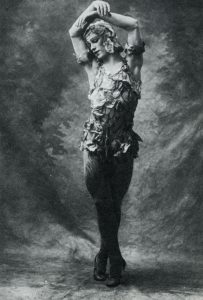
Vaslav Nijinsky was a principal dancer of the company and is remembered for his astonishing gravity-defying jumps and poignant portrayals. When Fokine left the company, Nijinsky became the principal choreographer. He choreographed the “Rite of Spring: Tales from Russia,” “Afternoon of a Faun,” and “Jeux.” Nijinsky’s dances were controversial because the themes, movement aesthetics, and music were unconventional for the time. “The Rite of Spring” portrays a pagan ritual and fertility rites that left the audience in uproar on its opening night.
Watch This
Excerpt from the Rite of Spring.
Léonide Massine (1895-1979)
Léonide Massine followed Nijinsky as a choreographer, where he expanded on Fokine’s innovations, focusing on narrative, folk dance, and character portrayals in his ballets. Parade is a one-act ballet about French and American street circuses. Pablo Picasso designed the cubist sets and costumes.
Watch This
Excerpt of Parade. The characters are introduced in three groups as they try to entice an audience into the performance. The giant cubist figures portray business promoters.
Bronislava Nijinska (1891-1972)
Bronislava Nijinska, the fourth Ballet Russes choreographer, was Vaslav’s sister and stands out as one of the few recognized women choreographers. Her ballet Les Noces, set to music by Stravinsky, was noted for its architectural qualities. She created several ballets known for being Riviera chic, portraying the carefree lifestyle of Europe’s idle rich.
Watch This
Excerpt from Le Train Bleu; you can see the costumes designed by Coco Chanel.
George Balanchine (1904-1983)
George Balanchine was the fifth and last choreographer of Diaghilev’s Ballet Russes. He created ten ballets for the company. The “Prodigal Son” is a retelling of the bible story. “Apollo” shows the birth of the god Apollo and his tutoring in the arts by the three muses. Those two ballets remain in the repertory of the New York City Ballet.
Watch This
Excerpt from Balanchine’s “Apollo” performed by Pacific Northwest Ballet.
Watch This
This short clip features pictures and footage with commentary by Lynn Garafola, Nancy Reynolds, and Charles M. Smith.
Ballet Russe de Monte Carlo and Original Ballet Russe
Diaghilev died in 1929, and his company disbanded with him. Two other companies emerged in its wake, the Original Ballet Russes and Ballet Russe de Monte Carlo. They would hire several of the dancers of the parent company and travel Europe and the Americas throughout the 1930s, ’40s, and ’50s. They spread ballet around the world, and their dancers would become the next generation of dancing masters.
The Five Moons
Many American dancers found work with Ballet Russe de Monte Carlo and Original Ballet Russe. Five exceptional Native American dancers who became ballerinas with these companies hailed from Oklahoma. Known as the Five Moons, a reference to their tribes, these women gained fame and success at the highest levels of ballet, and were foundational in the development of Oklahoma dance institutions.
Maria Tallchief (Osage Nation, 1925-2013) went on to dance with New York City Ballet. She married George Balanchine and worked with him for many years. Balanchine’s Firebird was a signature role for her.
Marjorie Tallchief (Osage Nation, (1926-2021), Maria’s sister, was known for her great versatility as a dancer. She had a successful dancing career in Europe and the states, then served as director at Dallas Civic Ballet Academy, Chicago’s City Ballet, and Harid Conservatory in Boca Raton.
Moscelyne Larkin (Peoria/Eastern Shawnee/Russian, 1925-2012) first learned ballet from her dancer mother. She starred at Radio City Music Hall and founded Tulsa Ballet Theatre with her husband.
Yvonne Chouteau (Shawnee Tribe, 1929-2016) joined Ballet Russe de Monte Carlo at the age of 14 where she danced many roles from the Ballet Russe repertory. She served as an artist in residence at the University of Oklahoma and founded Oklahoma City Ballet with her husband.
Rosella Hightower (Choctaw Nation, 1920-2008) danced with these major companies and with American Ballet Theatre, but she later found her work in France, as director of Marseilles Opera Ballet and then Ballet de Nancy. Hightower was the first American director of the Paris Opera Ballet.
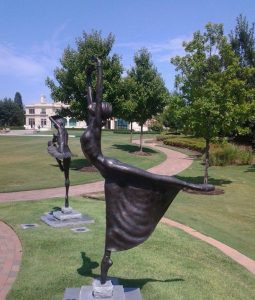
Neoclassical Ballet
Neoclassical dance utilizes traditional ballet vocabulary, but pieces are often abstract and have no narrative. Several choreographers were experimenting with the neoclassical style. Balanchine’s work is regarded as neoclassical, embracing both classical and contemporary aesthetics. Balanchine wanted the attention to be on the movement itself, highlighting the relationship between music and dancing by creating movement that mirrored the music. Balanchine also employed freedom of the upper body, moving away from the verticality of the spine for a more expressive movement that drew inspiration from vernacular jazz dance styles that became prominent.
American Ballet in The 20th Century
At the invitation of Lincoln Kirstein, George Balanchine went to New York City when the Ballet Russes ended in 1929. In 1934, they established the first ballet school in the United States, the forerunner of the School of American Ballet. It expanded into a short-lived dance company. In 1948, Balanchine established a small company that ultimately grew to become the New York City Ballet (NYCB). New York City Ballet is the resident company of Lincoln Center in NYC and one of the most recognized ballet companies in the country.
George Balanchine was a prolific choreographer with a long career. Due to his contributions to the development of ballet in the United States, Balanchine is known as “the father of American ballet.” He wanted to express modern 20th-century life and ideas to capture the spirit and athleticism of American dancers. Some of his most famous ballets include Serenade, Jewels, Stars and Stripes, and Concerto Barocco.
Watch This
Excerpt of the Rubies pas de deux from the ballet Jewels.
American Ballet Theatre (ABT)
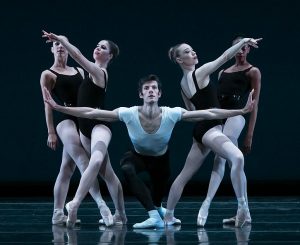
American Ballet Theatre (ABT), a New York City Ballet contemporary, is also recognized as a premier ballet company. Its mission is to preserve the classical repertoire, commission new works, and provide educational programming.
Its directors have included Lucia Chase and Oliver Smith, Mikail Baryshnikov, and Kevin McKenzie. Hundreds of renowned choreographers have created works with ABT. Antony Tudor created intimate psychological ballets, Agnes de Mille created ballets of Americana, and Jerome Robbins produced ballets across a range of styles.
Watch This
Excerpt from Rodeo by Agnes de Mille, the dancers mimic the bowed-legs of cowboys and trot about as if they are astride horses. Aaron Copland composed the music.
Ballet grew in other cities of America as well. San Francisco Ballet was founded by Adolphe Bolm, a Ballet Russes dancer. Chicago and Utah both established ballet companies early on.
Other Notable American Ballet Artists
Mid-20th Century:
Jerome Robbins (1918-1998)
Jerome Robbins was an American-born dancer and a significant choreographer in ballet, musical theater, and film. Robbins contributed modern ballets to the repertory of New York City Ballet and American Ballet Theatre. His artistic works are influenced by ordinary people and reflect current times.
Watch This
Short documentary that highlights scenes of Fancy Free with commentary by Daniel Ulbricht and Ella Baff. Fancy Free is set in the 1940s; this ballet is about the escapades of sailors onshore. Fancy Free is the precursor for the musical, On the Town.
Robert Joffrey (1930-1988)
In 1953 Robert Joffrey began his company, Joffrey Ballet, as a small touring group traveling in a single van. It is primarily known for its pop-culture ballets, like Astarte, and historical recreations of ballets like Nijinsky’s” Rite of Spring,” Fokine’s “Petrouchka,” and Massine’s “Parade.”
Arthur Mitchell
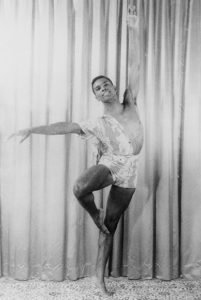
Arthur Mitchell was the first African-American principal dancer to perform with a leading national ballet company, New York City Ballet. In 1969, in response to news of Dr. Martin Luther King’s assassination, Mitchell created a ballet school in his childhood neighborhood. The Dance Theatre of Harlem rose from the ballet school, a classical ballet company composed primarily of African-American dancers.
Mitchell wanted to produce ballets that would raise the voices of people of color and create opportunities for them to dance professionally. He used his company as a platform for social justice. In his Creole Giselle, Mitchell reimagined the romantic ballet and set it in Louisiana during the 1840s. According to the Dance Theatre of Harlem’s program notes, “during this time, social status among free blacks was measured by how far removed one’s family was from slavery. Giselle’s character is kept the same; her greatest joy is to dance. Albrecht is now Albert, and the Wilis are the ghosts of young girls who adore dancing and die of a broken heart.”
Watch This
This archival material from Creole Giselle includes pictures and dancing clips narrated by the dancers of the original ballet, Theara Ward, Augustus Van Heerden, Lorraine Graves.
Check Your Understanding
